I was initially inspired by the aesthetic of mosaics. I love the texture and the various applications, as well as the potential to use recycled materials, whether broken glass, pottery, beads, etc. A lot of the mosaic projects I am familiar with are classic cement-based or grouted ones, such as my inspirational examples below.
Inspirations:
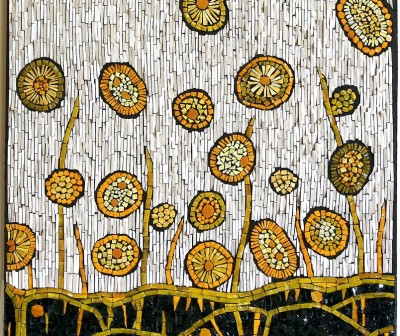
(From http://www.mosaicartnow.com)
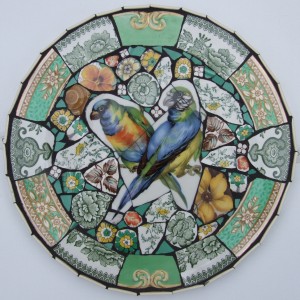
(From http://kellygardnerartist.wordpress.com)
While I love the function and design of these firm-set pieces, I thought it would be interesting to try and implement a soft-set mosaic, one that is somehow attached as accessory to a fabric item.
A while ago, my cat knocked a china tea cup and saucer off of my counter and broke them, and I held on to the pieces hoping to do something useful out of them. In this way, my design process started out a bit differently than the idealized design loop that my team and I came up with.
In the idealized process, we started with a problem that needed to be solved, where as I began with a material I wanted to use (which, in a way, is a problem in itself but not the kind that we intended to suggest within the idealized model).
Idealized Design Loop:
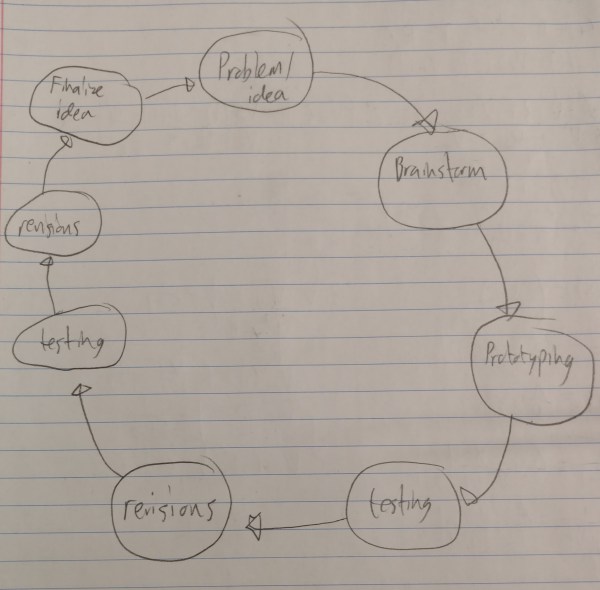
(From Brendan Lee‘s Design Flow Chart Post)
My Actual Design Process:
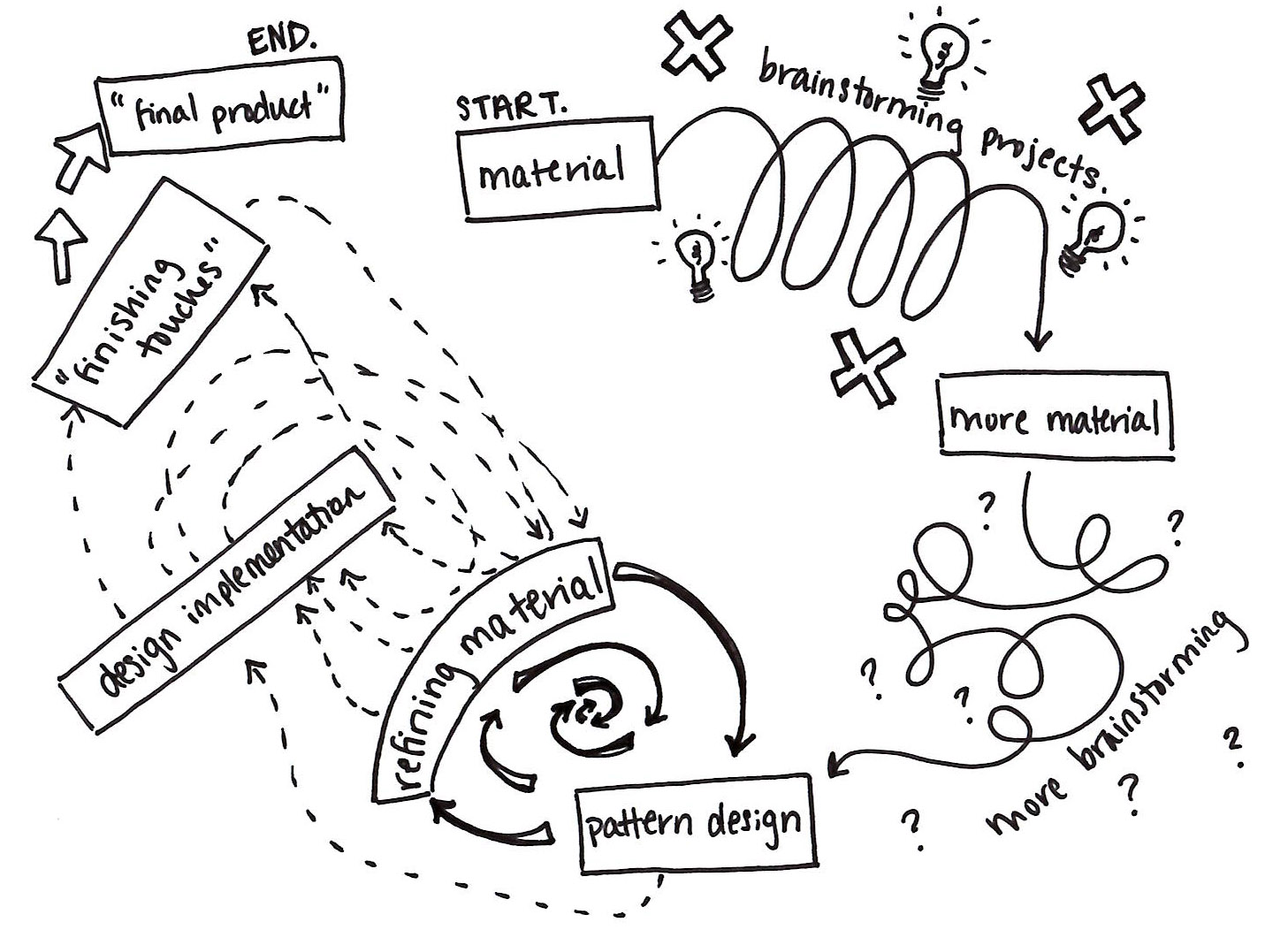
Notice that the brainstorming of project ideas and applications remained as the second step, but in the actual design process it was revisited again and again, leading to dead ends, inspiring further material gathering, and then back again to brainstorming ways to incorporate the new material. It was during this time that I was picking through a thrift store and came across a soft, vinyl-coated fabric purse, and decided to apply the mosaic to its front.
After arriving at this viable project idea, I then entered an iterative loop of trying to design the pattern for the mosaic, refining the broken china pieces, tacking them down with glue, and in some cases, hating the way that looked and revising the pattern, re-refining the piece, and re-tacking it down with glue.
The Refining Method:
I started with broken pieces from the original tragic accident, but in some cases I needed to reshape certain shards to fit my pattern. I started by gently chipping them with a chisel and hammer.
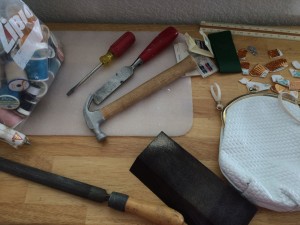
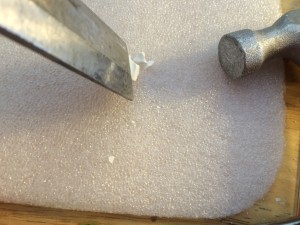
Once in the correct shape, I put all the pieces through a sanding process to ensure that particularly sharp edges would be ground down, and all of the pieces would have (mostly) uniform, smoothed edges. First the pieces were roughly ground down by an iron file. Next, I finished polishing the edges with a finer grit sanding block.
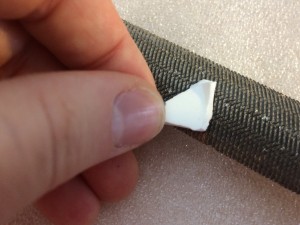
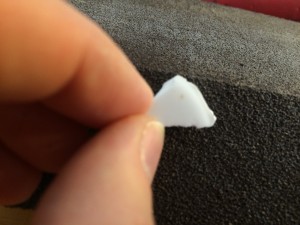
[Above left: File for rough grind. Right: Sand block for smooth finish.]
Application:
When the pieces for my design were refined, I checked their fit within the design, refining more if needed, and began the application process. This consisted of tacking on each piece with hot glue in the appropriate spot, and then stitching across and around the piece to ensure its adherence. I did not want to use hot glue as my only method of attachment, both because the vinyl surface of the purse did not take very well to the glue once it had dried, and because the stitching added another texture visually and physically. I wanted the stitching to represent the grout or cement of a traditional mosaic project. It adheres the pieces to the surface of the purse, but it also separates them visually and adds an extra dimension to the project’s appearance.
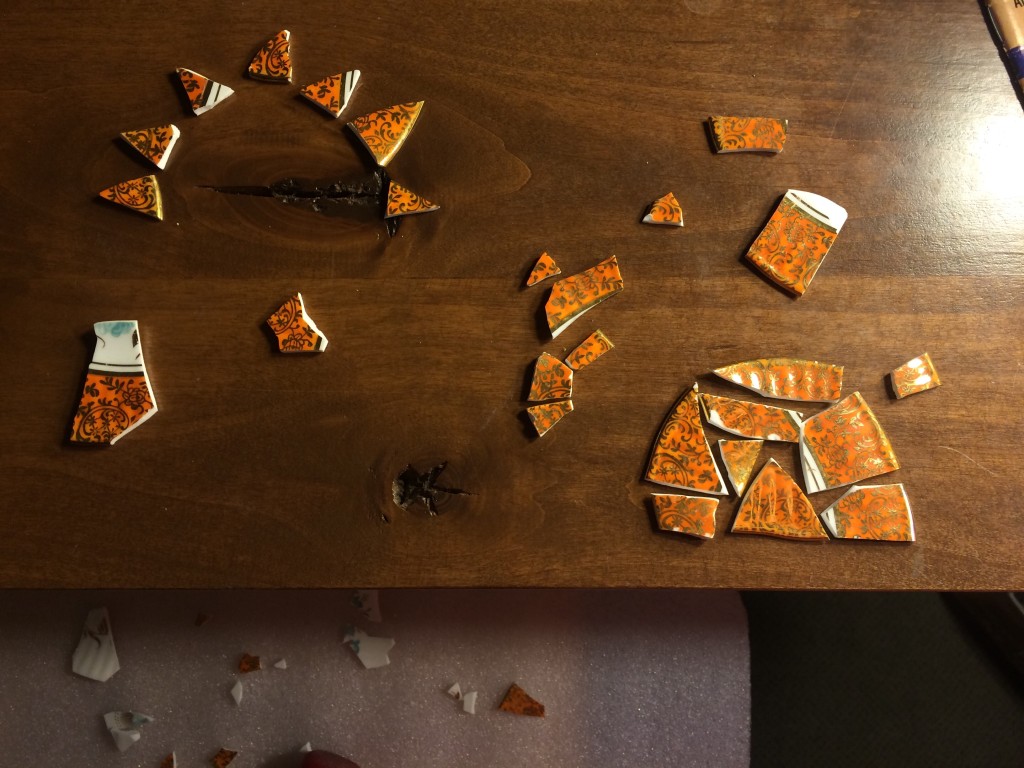
[Above: The pieces laid out before attachment.]

[Above: Stitching the pieces on.]
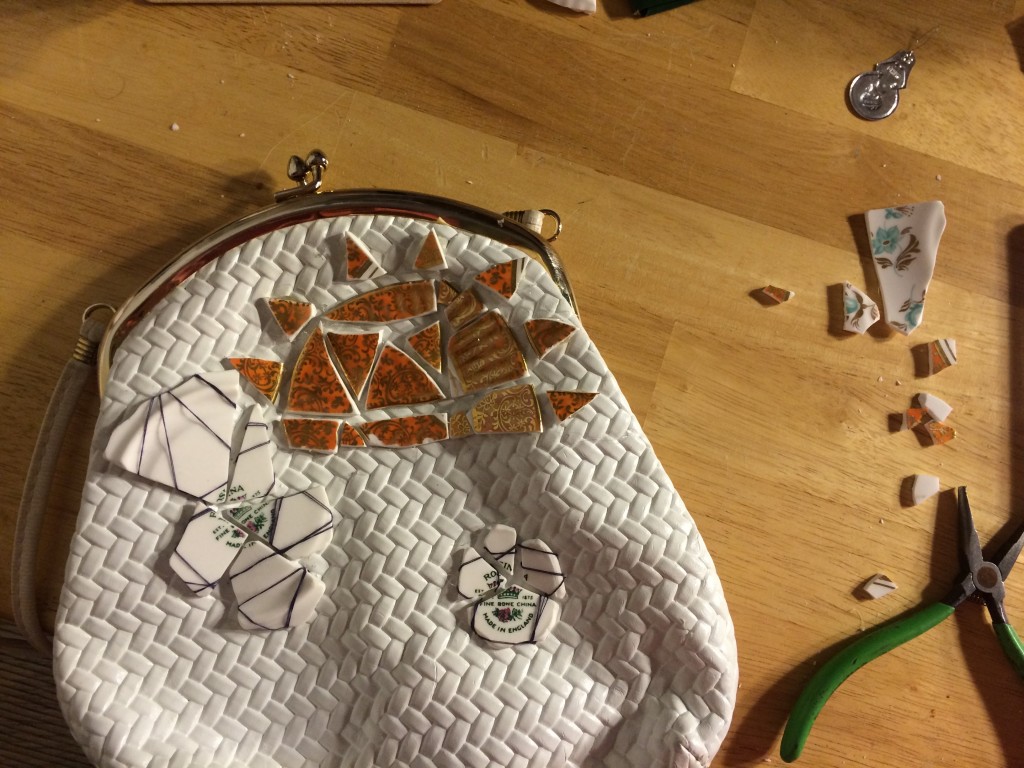
[Above: re-refining some pieces.]
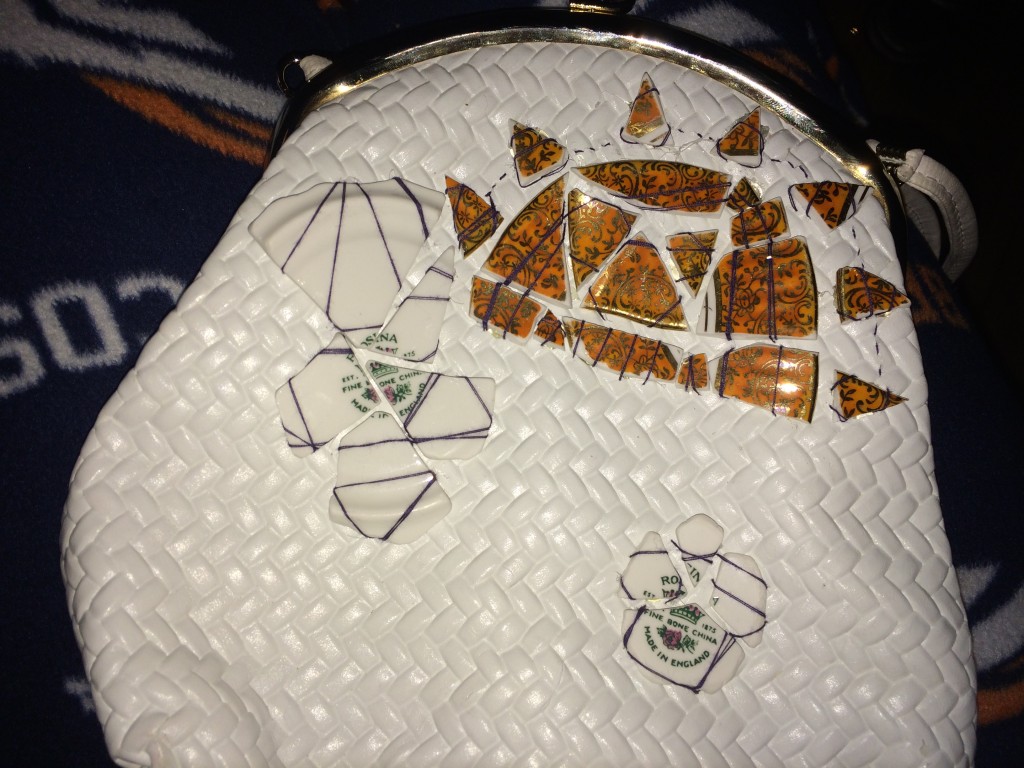
[Above: Adding extra stitches as a design element.]
The actual design process devolved as I went along, and lines between steps were blurred, especially towards the “end” of the project. Constantly I went back to the design stage to reformulate my artistic vision, even in the midst of the “finishing touches” stage. For example, I decided halfway through stitching that extra stitches around and outside the pieces would help to fill the empty space and create more visual interest.
Even the “final product” is in quotations because the design process persists every time I take another look at the project. I might go back and add more stitching, or perhaps continue to add pieces of broken china or glass or the odd button lying around, or maybe I will paint the remaining space. I tend to overthink and over do things. Maybe I will just leave it alone. In general, this is how my actual process diverged from the idealized one, as ideally you would revise but then move on to the next step until the project is as finished as it can be. I seem to get stuck in a cycle of new inspiration and then lack of inspiration, doing too many things to the project and then getting sick of how much I did to the project. I should probably leave it be.
Functional and Artistic Vision:
Once I settled on the idea of creating my mosaic textile on the purse, I turned to the colors of the tea cup and saucer to inspire the design of the pattern. There are rich golds and oranges in the border pieces, nicely contrasting from the soft blue, floral design of the body pieces. That color combination reminded me of Van Gogh’s Irises and Sower with Setting Sun, so I was inspired to design a sun pattern with the gold-orange pieces. I liked the brand marks from the underside of the tea cup and saucer, so I used those as the center and body of iris-like flowers. I used the blue-flowery pieces for the stems/leaves.
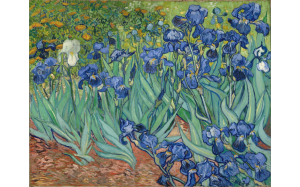
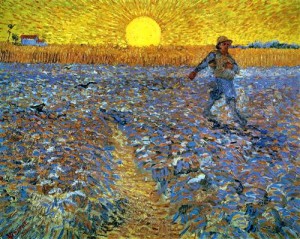
(Irises by Van Gogh, from The Getty Museum) (Sower with Setting Sun by Van Gogh, from WikiArt)
For contrast and to further promote this color scheme, I also chose a dark navy thread for the stitching.
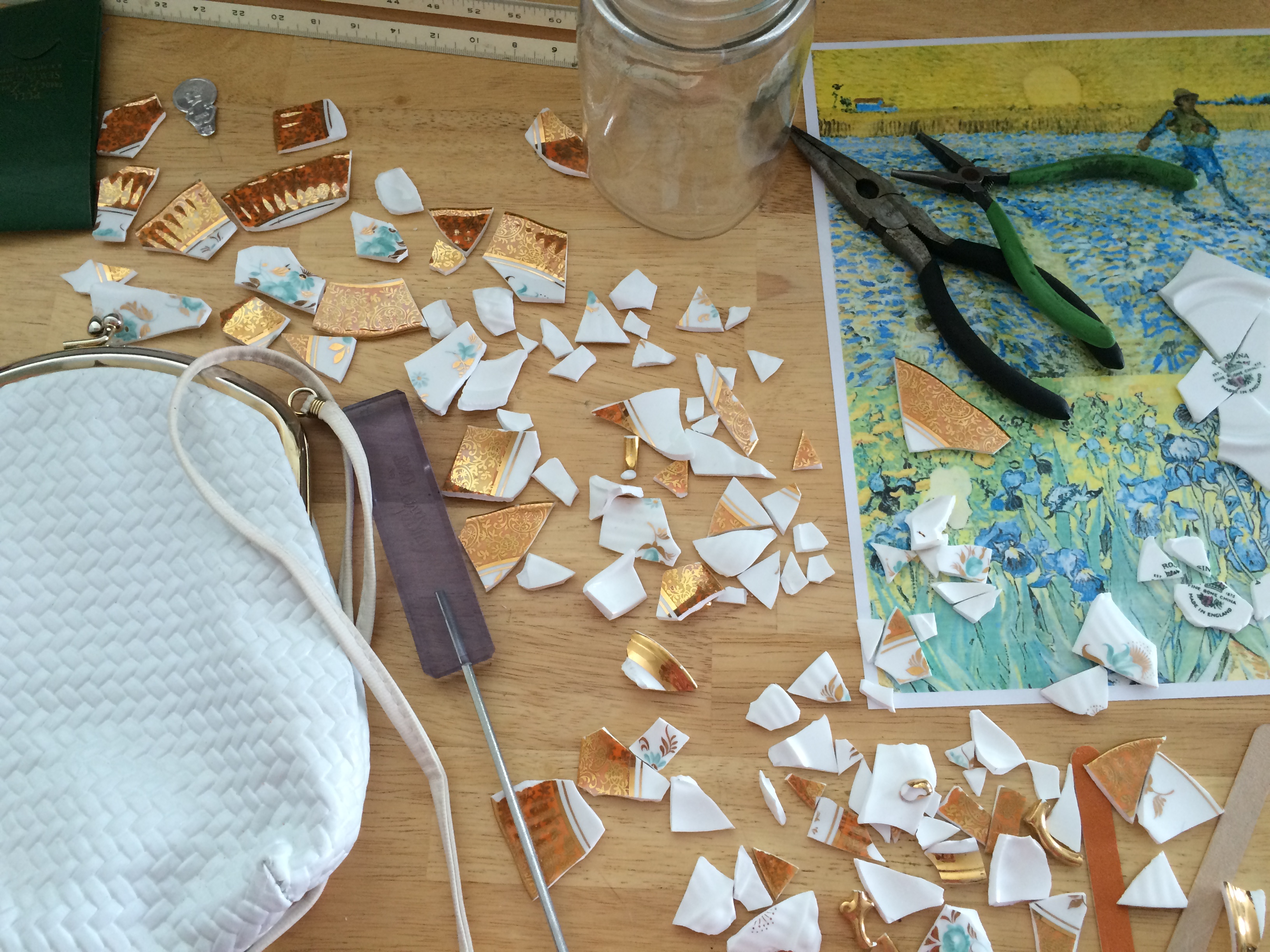
[Above: The paintings and the pieces during creation.]
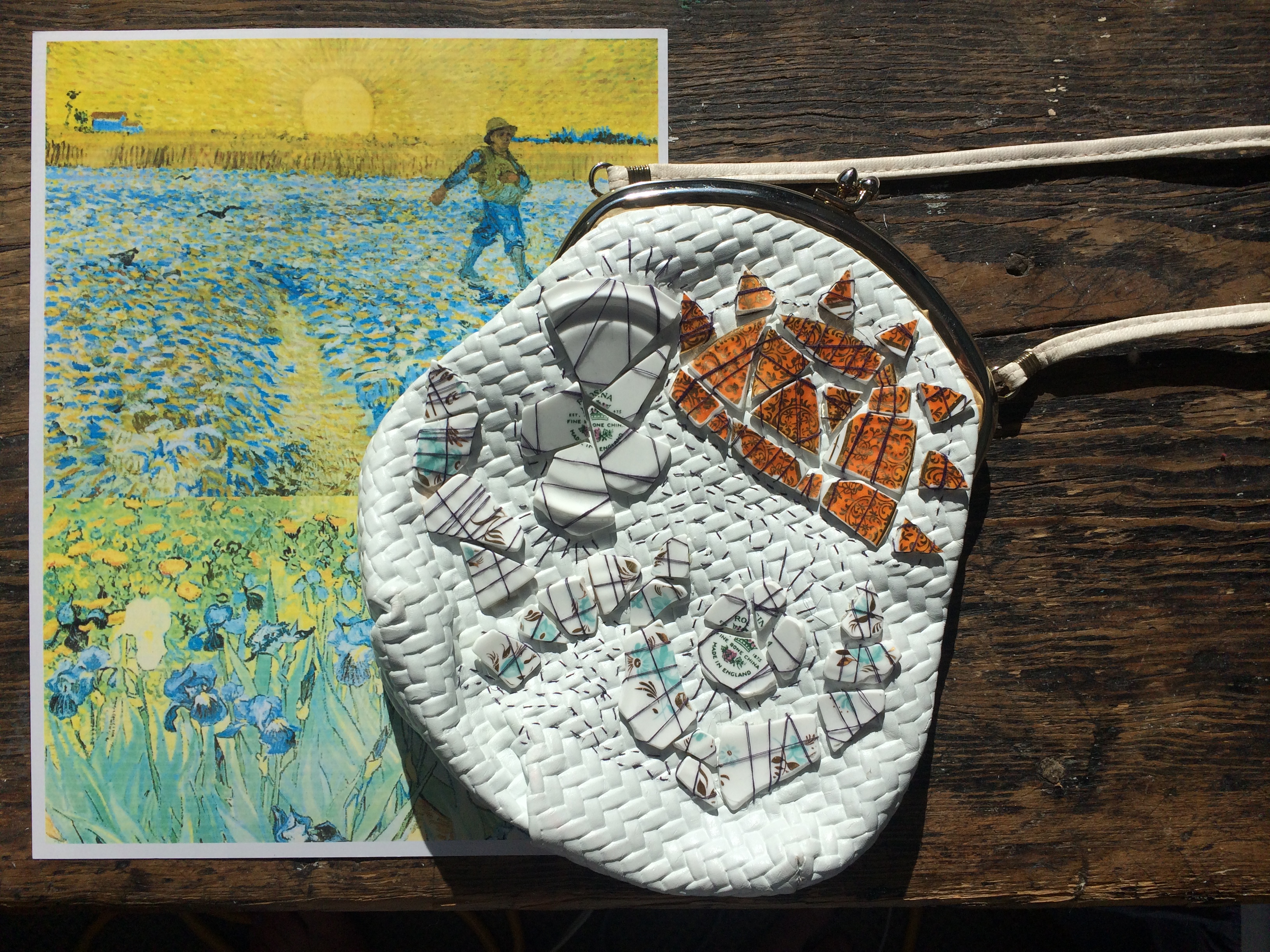
[Above: The “finished” product and the paintings.]
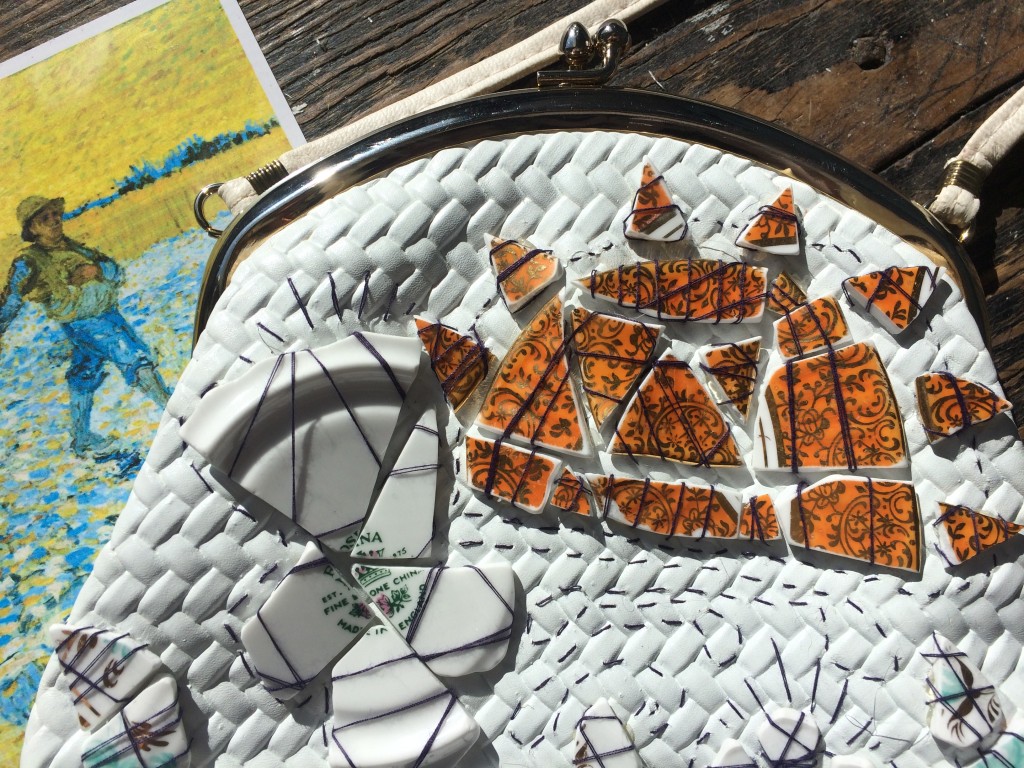
[Above: Detail shot.]
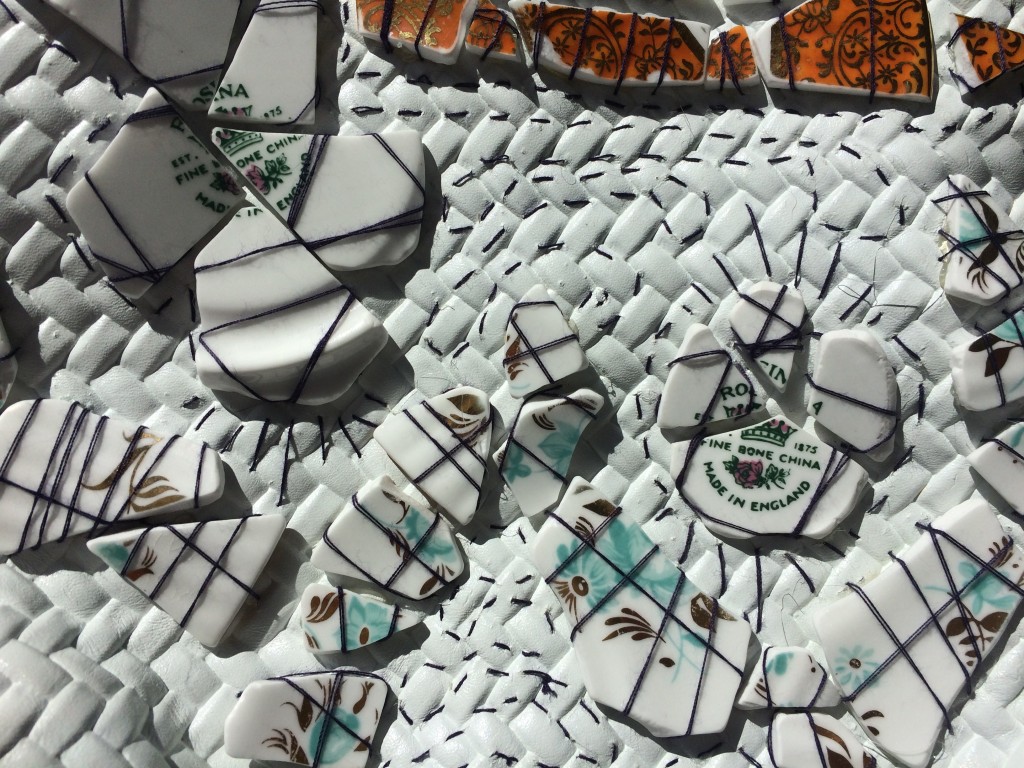
[Above: Closer-up of stitching and irises.]
Functionally, I wanted the stitching to secure the pieces to the purse, which ended up working, though differently than I intended. Initially, the stitches were only going to be around the edges of each piece, however my refining method worked so well the edges were too slippery to hold the thread up. Therefore, I had to modify the design to add stitching over the top of each piece, which did allow me more artistic expression. I tried to use the stitches as details, to unify the elements in each part of the design. The sun has a specific stitch-pattern, as do the iris leaves and petals. The decorative stitching around the pieces was also inspired by the paintings, as I tried to make it more whimsical and flow-y like the lines in the art.
Artistically, I am happy with how what I achieved honors my inspiration and fulfills the mosaic aesthetic I was going for. I was able to upcycle those broken pieces of china in a way that was motivated by the tea cup and saucer’s original artistic presentation. The colors lead me to the paintings, which lead me to the mosaic design, which upheld my initial project idea. However, I am open to further improvement depending on how I am inspired in the future, and how this piece fits into my life and personal aesthetic.
Which brings me to the functional achievement of the piece. The early specification for this project’s function was really just to use these pieces as decoration, and to make sure they were smooth enough that the purse was a safe accessory. However, as I worked on the project, I realized I would never really need or use a purse this small.
I got to thinking, and because a lot of the mosaic aesthetic is particularly a garden mosaic aesthetic (i.e. mosaic garden tables, stepping stones, ceramic/clay pots), I thought it would be interesting to use the purse as a hanging plant holder.
It seemed a useful solution, so with a few minor adjustments (to hold the purse open as it hangs), that’s what happened.
I am very happy with the whole look, especially as the sun comes in the window and reflects off the glazed china pieces. Its purpose may evolve as time goes on, as well as its appearance, but for now I am very pleased with the resulting upcycle of the tea cup, saucer, and purse.
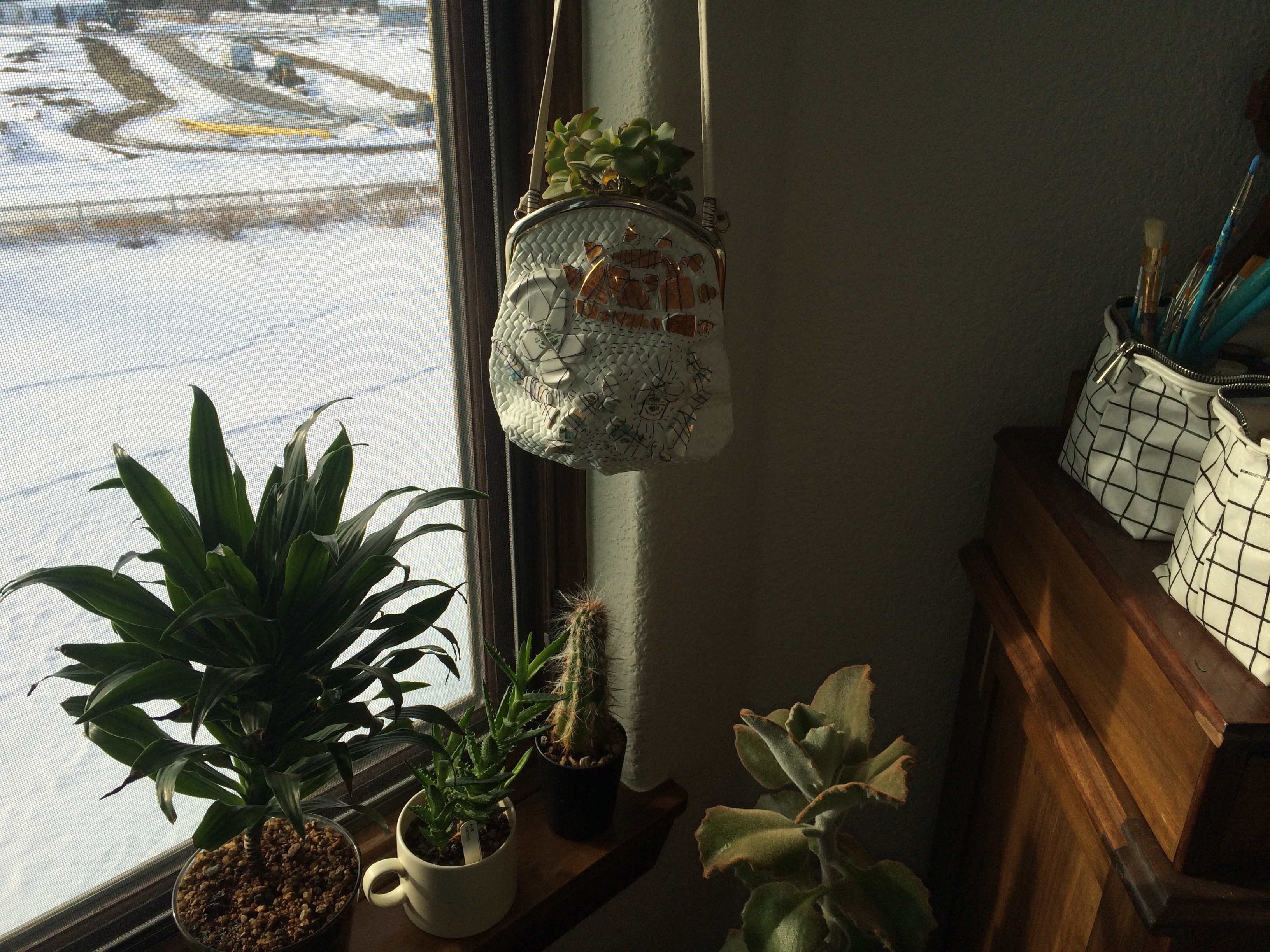
[Above: Hanging plant purse in place.]
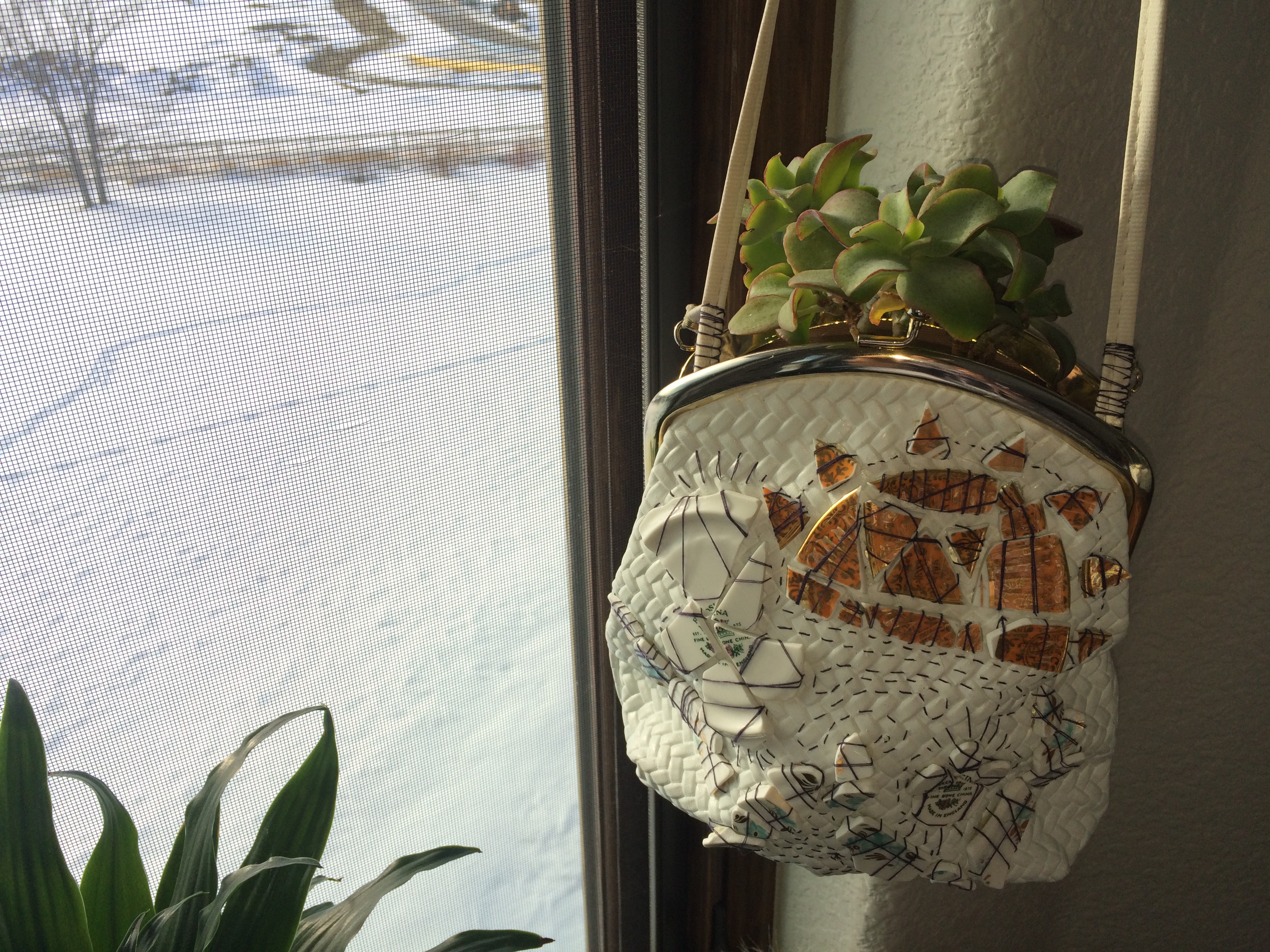
[Above: Close-up.]

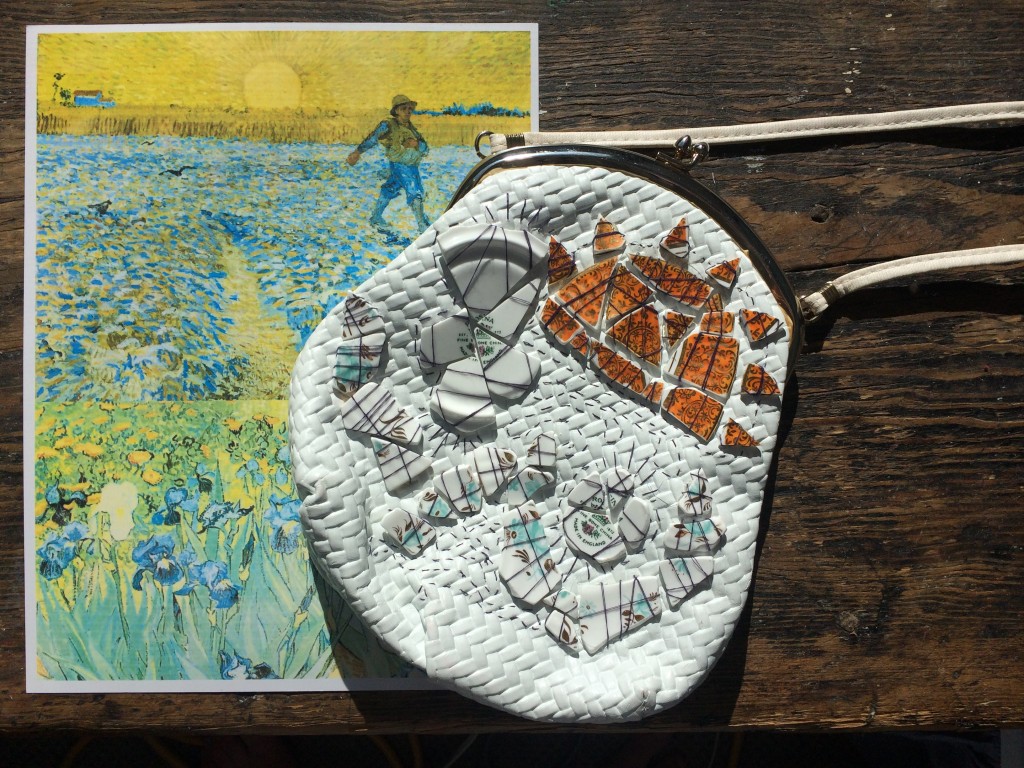
41 Comments. Leave new
I like the designs in the stitching itself, they’re a nice addition. Well done!
Well, as they always say, when life gives you ponies, make glue! I think you did a great job salvaging your cat’s contributions. The layout and colors work really well, and it felt very well made in hand. Do you think it’s rugged enough to serve as a purse?
I like how your design process started with your cat’s behavior. Your design process looks awesome. It’s almost like the shattered dreams of the white telephone madam of your aesthetic exploration earlier.
That’s super pretty! What an awesome way to use broken stuff. I tend to throw anything I break away, which I’m seeing very quickly is a silly thing to do with cool projects like this that I could do! I also love impressionism and you totally hit the nail on the head with your aesthetic. Great job!!
This came out really nicely. I am from Arizona and this definitely remind me of the southwest culture.
That’s a clever way of re purposing an otherwise broken tea cup. Making it into a flower holder is a cool compromise, since you said that you don’t necessarily want to wear it out.
Very pretty. I like the whole soft shell base you went with and how the tea cup pieces are arranged to look like a sun
Very cool medium, I think you’re the only one of us using ceramic shards for this project, really unique idea. I also loved how you stitched them on instead of adhesive, I think it makes it more of a genuine product/project.
Great job! I like that you were able to create something that was functional as well as a piece of art. I had never though of sewing porcelain to fabric before, cool idea!
Very interesting use of broken china and a handbag. It would be cool if the broken china was also on the other side of the bag. Nice work!
I really like your bad design. It looks like something that can be sold in a store. I like that it was used as a plant holder, but it also looks like it can be used as a bag. It was interesting to see how you attached your shards to the bag. Are there any changes you would make/want to make to improve upon your design?
I really like your bag design***
It’s a bummer the cup broke, but I love what you did with the pieces! It was cool to hear about your design process, it’s great that you were able to let the material define the project, that’s never worked for me. I don’t think I’ve ever seen hard mosaic tiles on a soft medium before. While using the purse as a purse might be difficult, I think using it as a planter is equally unexpected and very unique. Was is difficult to sew through the vinyl? Also, are the pieces really secure, or would it be easy to pull them off accidentally?
I really like the use of embroidery to secure all the ceramic pieces to the fabric of the purse. You don’t often see that technique used for functional purposes, rather just for artistic expression. The thing about your project which surprises, and impresses, me most is how organic all the pieces feel. It doesn’t feel like you had to make many adjustments to the broken pieces to be able to get them to meet your project or aesthetic needs. Organic seems like a more fitting word than any other for this project, being that you are now using the purse to hold plants!
I love the sun! The idea on the whole is creative and well executed. I do think a bit more color would be nice.
I think the up-cycled product is definitely better looking and arguably as useful as the original, nice work!
I was impressed by the way that you used a challenging material (porcelain shards) and refined them into a new object, while retaining their original beauty. Nice work!
Very cool use of broken ceramics… I like the dual functionality of the piece as a purse or plant holder. Also, interesting to see the stitching implemented with the adhesive.
I really like the incorporation of the living plant with the aesthetic of the purse and tea cups. It looks almost like someone took one of the paintings above and shattered it over the bag and some of the pieces stuck. You can really see the influences of the aesthetic in this project.
The impressionist painting are a great source of inspiration. I imagine it was really doffocult to stich from the inside of the bag. I wonder it it would be possible to apply a small dab of epoxy to the back of each piece, and let it set before starting to stitch. This may make it a little easier to lay it out before starting, and it would keep them in place while stitching. Really nice job!
I love mosaics and this was a particularly clever use of a broken tea cup. The handbag is useful for showing off your artistic touch.
Your cat is an evil being. Fortunately, this tragedy has turned into something beautiful. It is such a cute project and good use of something that can no longer be used. I also think it’s great that you ended up storing your plants in it! Great application!
this looks like the start of a very purchasable purse – break some more cups and make more! great work.
Cool idea for the plant holder! That’s kinda up-cycling in itself. The stitching is awesome!
I really like the purse! It was an interesting way to make an accessory using scrap china tea cups, which have their own unique aesthetic. Your design loop drawing was a lot of fun to navigate through, and wasn’t just a bunch of square blocks in a row.
Great aesthetic. I have never seen ceramic mosaic on textiles. You took come nice of it photos on your blog. I see that you sanded down the sharp ends of the ceramic. Maybe have different color stitches. Otherwise this is a great save for a broken piece
I think that it is so cool that you did not immediately throw the broken cup pieces away and wanted to put a use to them! The product also looks great – the sewing was an awesome touch and I’m not sure that I would have though of that solution.
Very cool and artistic. I especially like the sun. How long did it take you so sand the sharp edges away?
I like that you re-used a broken tea cup and made it into something special. It actually looks really nice as a plant holder and the simple colors make for a relaxing look.
Love the idea and the way it turned out. Excellent design process and way to make it a very dynamic piece of art
Looks pretty. I would recommend that you don’t use a white teacup in the future since you are putting white on white. Using broken teacups was a nice idea, and a positive spin on an unfortunate accident. How easy would it be for the pottery to break again or become dislodged from the purse?
I love the look of mosaics especially made from broken ceramic. You purse turned out very well and I love the integration of impressionism. In the future, it might be interesting to use purse color that allows the ceramic to stand out more clearly.
I was a bit concerned that the pieces would fall off if they got snagged during use, but using it as a plant home is a great way to get around this! Nice work! Very good semi-embroidery job!
The stitching brings this to life for me, like that the overuse draws the eyes in to the details of each piece. Also like the final use as a plant holder, very ingenious. Good work.
Creative project! I think there is a bit too much white space. The color of the ceramic and the bag blends in too much I think. Using different colors would offset the purse more. Cool idea using it as a plant holder.
I love the additional stitching you included around the pieces! I really love how you created a flower pot out of the purse! Amazing design and ideas!
Your design loop is a work of art all by itself. I appreciate the way you let your aesthetic goal guide your process.
this is a very beautiful piece I only wish if you had gone different colors since the china and the background both are white.
I really like your passion for mosaics. I think its cool you are taking something broken and reassembling it into something new. I do wonder whether the mosaics get caught on anything though and are sharp? What drew you to creating the design on the purse?
Glad to see that your project went well! Looks like you found an aesthetic to go for and pulled it off. I like how you used china pieces with designs on them instead of flat colored ones to give your art some character, and how you used a purse with that weave pattern that complimented the mosaic well. A mosaic purse wouldn’t be practical to use as an everyday purse, so it was also great that you found a good way to use it (plant holder). Good job!
I’m glad you found a source of artistic inspiration for your mosaic! I remember you saying you wanted to make a mosaic but weren’t sure of the artistic direction. I really like the addition of the stitching and how you are using the purse as a hanging plant holder. Overall really cool project!